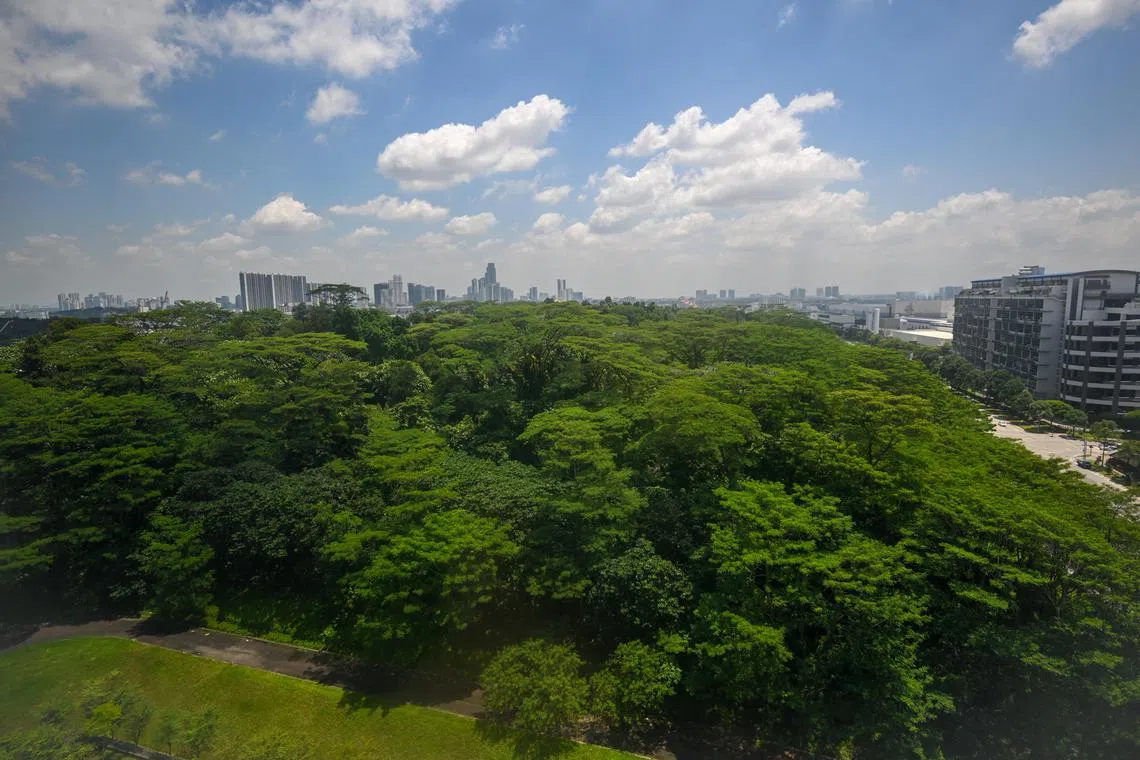10.4ha of forest in Woodlands to be cleared from 2026 for industrial, mixed-use developments
Sign up now: Get ST's newsletters delivered to your inbox

Forested land off Admiralty Road West on Aug 22. It will make way for Woodlands Gateway, a hub for advanced manufacturing activities and companies.
ST PHOTO: SHINTARO TAY
Follow topic:
SINGAPORE – Some 10.4ha of forest in Woodlands is slated for clearance from 2026 to build industrial and mixed-use developments for an upcoming precinct highlighted during the recent National Day Rally.
The vegetation, about the size of 15 football fields, will be cleared to support new industrial developments that tap the Johor Bahru-Singapore Rapid Transit System (RTS) Link
This was revealed in an environmental impact assessment published online on Aug 20 by site developer JTC Corporation (JTC).
It told The Straits Times that the works for Woodlands Gateway will ensure that the land is suitable for construction, with essential infrastructure such as roads, drains and utilities. JTC also said the project will become an employment, commercial and manufacturing hub, which will support manufacturing companies with operations in both Singapore and Johor.
JTC said site preparation, such as soil investigation and surveys, are planned to commence in 2025, ahead of any works. Works at the site are scheduled to be completed by 2035, according to the report.
During the Aug 17 National Day Rally, Prime Minister Lawrence Wong elaborated on plans to revitalise the northern regions
These plans include flexible industrial spaces around the RTS station that support businesses seeking to take full advantage of the Johor-Singapore Special Economic Zone, as well as new homes along the Woodlands waterfront.

An artist’s impression of flexible industrial spaces around the RTS Link station in Woodlands.
SOURCE: JTC CORPORATION
The 27.7ha project site studied for the environmental impact assessment is next to Woodlands North MRT station and bound by Admiralty Road West and North Coast Avenue.
Apart from forested land, the site also has the premises where the British Naval Police were once housed. The premises were repurposed for the now-defunct View Road Hospital, and then a foreign workers dormitory that ceased operations in 2011.

The Urban Redevelopment Authority (URA) previously said it is studying how the building can complement
JTC said “no specific decisions” have been made regarding the development of the compound.
The environmental study for the site was conducted by consultancy DHI Water and Environment in 2024.

A Psychotria polycarpa plant in the project site off Admiralty Road West..
PHOTO: DHI WATER AND ENVIRONMENT
The 274-page report found that the 13 native flora species of conservation value dotting the site will be adversely impacted by the development. These include thriving clusters of Psychotria polycarpa, a scrambling shrub adorned with tiny white flowers that is critically endangered in Singapore.
Also among the affected plants is a locally endangered ground-dwelling fern that the study said had been recorded almost exclusively in forests in Bukit Timah, where fragments of Singapore’s last virgin rainforest can be found.
As the Tectaria semipinnata plant is not known to be cultivated in Woodlands, the report concluded that the two ferns found come from a limited native stock in the wild. Only between 50 and 250 mature individuals of the species are estimated to remain.
JTC said that as suggested by the study, it will strive to create green spaces within the development, and plant salvaged saplings or similar species there.
It added: “Plans for future industrial development will integrate greenery to harmonise industrial growth with environmental conservation measures.”

One of two Tectaria semipinnata ferns in the project site off Admiralty Road West.
PHOTO: DHI WATER AND ENVIRONMENT
At a broader level, the report noted that the site was not a key link for wildlife moving between forest plots, due to the surrounding urban landscape comprising industrial buildings and residences.
Most of the bird and butterfly populations are also likely to relocate to nearby habitats, the study found.
Even Admiralty forest – the nearest forest plot to the site – is slated for development into a business park, according to the URA’s Master Plan 2019, which guides developments in Singapore for the next 10 years to 15 years.
Still, the loss of forested land in the project site is anticipated to have a minor impact on wildlife that can fly, such as birds and bats.
These creatures can use the patch as a pit stop between the fringing habitats of Admiralty Park and mangroves, and the Central Catchment Nature Reserve.
JTC said that inspections will be conducted with a trained ecologist during construction to check for the presence of wildlife before trees are felled.
Works will be postponed if active bird nests are found on trees marked for felling until the nests are no longer used.
Wildlife specialists will also be engaged to translocate any wildlife found to be trapped within the construction site.
For humans, dust emission from large-scale earthworks due to land clearance and levelling works is expected to have a minor impact on the neighbouring Man Fut Tong Nursing Home just 115m south of the project site.
The elderly there are more prone to respiratory discomfort or diseases arising from the elevated concentration of construction dust without mitigation measures.
Therefore, the study called for strict measures such as dust screens and the monitoring of wind speeds, to reduce the spread of airborne particles.
The environmental impact assessment, which can be accessed on JTC’s website, is available for public feedback until Sept 17.
Among those interested in the project is Republic Polytechnic graduate Jayden Kang.
After learning in 2023 that the forest behind his polytechnic, which is located in Woodlands, was being cleared for future development, he has been tracking the developmental plans for the area and scrutinising related environmental studies.
Since 2021, there have been a total of six environmental studies for various developments in Woodlands published on URA’s website. They were commissioned by JTC, the Housing Board, and the Immigration and Checkpoints Authority.
Mr Kang, the head of Singapore Youth Voices for Biodiversity’s outreach team, said the recent environmental impact assessment was “satisfactory”.
But he critiqued the “piecemeal” approach in conducting multiple small environmental impact assessments in Woodlands.
He acknowledged that the various governmental agencies have “little to no choice” but to clear the forests in the small parcels of land they have been allocated.
Said Mr Kang: “The biggest issue now is that the land parcels are tiny, and the good forest patches extend between multiple sites, but it has to be cleared to fit JTC’s buildings, HDB’s Build-To-Order flats, and other developments.”
“In my opinion, an assessment should be done by URA for the whole area before splitting the land parcels with mitigation measures in mind, and thus saving more forests.”


